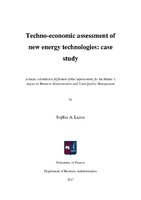| dc.description.abstractEN | This thesis examines the implementation of new energy technologies in organisations and assesses techno-economically a solar photovoltaics technology. The study is partitioned into three main parts.
The first part comprises the literature review, with primary focus given on innovation and energy efficiency and the tangential relevance that these elements have on securing a sustainable future. The words “new” and “energy technologies” represent the latent notions of “innovative technologies“, “energy-efficient technologies”, “clean technologies” and “energy management practices” within this thesis’ purview. In order to cover the economic dimension of those notions, heed was given to the nexus between innovation and economic growth as well as the nexus between energy efficiency and economic growth. At the end of the first part, a reference is also made to some of the world’s new energy technologies.
The second part constitutes a research on the relationship between an organisation’s approach towards innovation and the incorporation of energy management practices within its functions. The flimsy attention given to this topic in Greece, acted as a jumping-off point for this research. Besides, any nuggets of information would be a contribution to the existent literature, while it would potentially kindle other researcher’s interest and serve as an inception work for anyone willing to delve deeper into the subject. The survey was conducted with the use of questionnaires and included 278 organisations with offices and registered activity within the region of Attica (but not strictly confined to this specific region). The method of sampling technique adopted was stratified sampling – probability method - in order to produce as due results as possible.
The third part, following the interest of this thesis on the investigation of new energy technologies, presents a techno-economic analysis of a relevant technology. The project explores the siting of solar photovoltaics on areas, which are potentially contaminated (brownfield lands) and is based on a real feasibility study carried out by the National Renewable Energy Laboratory (NREL) of the USA. Specifically, the project refers to a commercial-scale PV system with 348kW installed capacity, privately purchased and with a power purchase agreement (PPA) in place. The land, though is assumed state-owned. In the third part, useful information about conducting a techno-economic analysis are cited as well, among them the strengths and weaknesses of each investment appraisal technique. | el |



